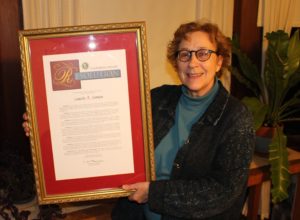FVCA presented Laurie Soman, director of the Children’s Regional Integrated Service System (CRISS), with a resolution from Senator Loni Hancock’s office in recognition of her 20 years of leadership as the director of CRISS and lifelong service to children and youth with special health care needs (CYSHCN). As the director of CRISS, a 27-county collaborative that works to create a seamless system of care for kids in California Children’s Services (CCS), Laurie spearheaded the first statewide family-centered care survey, a CRISS durable medical equipment survey, and a CRISS maintenance and transportation survey for CCS.

In addition to her work with CRISS, Laurie is the manager of policy analysis at Lucile Packard Children’s Hospital where she specializes in improving access to care for children with special needs, the project director for the CCS Medical Advisory Committee, a key stakeholder on the statewide CCS Redesign Advocacy Group, and a team member at the Alameda County Mental Health Initiative (the list goes on)!
We spoke with Laurie about her vast experience with systems of care, family engagement, CCS, and more.
How has the CYSHCN family engagement landscape changed over the years? What have been some other notable shifts in child advocacy?
There’s now a general recognition in the child advocacy community of not just the importance of family involvement, but the absolute necessity of it—this took a while to build. In terms of my own work, we didn’t initially involve families at CRISS. It took us a couple of years. That was the beginning of what I like to call the three-legged stool: you want to work with programs and providers, but you also need family and youth input.
In decision making, families need to be involved at every point along the way. Current research shows that as far as board representation, there needs to be a critical mass of at least three people from an underrepresented population on a board for their voices to be heard—there must be multiple family representatives on boards or advisory councils. Family members can’t just be plucked out—they have to be backed by an organization so they’re representing more than personal experience. So you have (power in) numbers, educated parents, and parents who are supported by an organization. Those things have become very critical.
Interest among the larger child advocacy community, in terms of attention to kids with complex special health care needs, has grown a lot over the past few years. With regard to CCS issues, there’d always been five key organizations at the table. This year, as we worked on SB 586, Senator Hernandez’s bill concerning CCS redesign, we knew we needed to build a larger coalition. I’m really surprised and proud of what we’ve been able to build over the last few years.
What are some issues with care coordination you’ve observed?
In California, we’ve divided our systems so clearly. We have medical, mental health, behavioral health (in terms of autism service), developmental health, and special education. Each of these segments may have a care coordinator, but they only manage their one particular piece. So, individual family members end up assuming the role.
I definitely see some steps forward with both systems and advocates wanting to make change. We can spot places around the state where care coordination is more widely recognized as a problem because families are driving the point home that they’re the ones who get stuck taking care of things.
At the state level, there’s a sense that perhaps the siloing of the different systems isn’t the most effective or cost-efficient way to do business. For example, Senator Pan’s Select Committee On Children With Special Needs is explicitly interested in coordinating across the multiple systems—even breaking down some of the walls separating these systems.
How can parents get involved on behalf of CYSHCN?
All of the children’s hospitals are setting up family advisory committees and have family-centered care programs, and that’s all relatively new. You might have the most wonderful medical care, but is it organized in a way you can use easily? Is the experience optimal? Providers know having families involved is the right thing to do, and it ultimately results in better care and outcomes. Families really had to struggle and push for a while, but providers are now seeing how humane and correct it is for them to be involved.
How can we ensure a smooth transition for the children moving from CCS to Med-Cal managed care plans next year and that all families are informed?
The state is responsible for creating timely, understandable, and correct material any time a change is made. The question from an organizational standpoint is: is the timing going to be good enough? Organizations are saying that we need to get this information out now. The plans want to create their own materials as well, and they’re waiting for the official word from the state.
Family organizations should continue meeting with the plans and providing family input to ensure that perspective is considered. There’s also going to be a real role for organizations to make sure families are aware of their rights. For instance, families will have a 90-day window to elect to keep their child’s CCS nurse manager. I think there’s going to be ongoing monitoring we’ll all need to participate in once SB 586 rolls out. Up until now, we’ve been dealing with a state-level program. Now, the responsibility falls on individual plans.
What’s one quirky thing you want people to know about you?
I like to fix things. I used to be a cabinet maker and had a business in Berkeley for years. I got in trouble as a kid because I would always take things apart. My grandparents had one of those old, heavy phones. I thought it was fascinating, so I took the whole thing apart when I was 4 years old and then put it back together.
